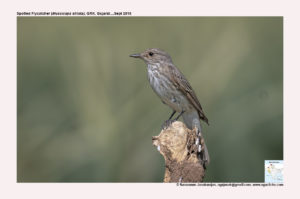Spotted Flycatcher

Spotted Flycatcher Muscicapa striata
Etymology:
- Muscicapa : Latin Word musca – fly; capere – to catch
- Striata : Latin word striatus –striated
Vernacular names: Guj: Khakhi makhimar, Diwali makhimar
Distribution in India: Passage Migrant in North West India.
Description:Size of 13·5–14·5 cm; wt. of 11·2–21·9 g. The nominate race is mousey grey-brown above, paler from forehead to forecrown. The forehead to nape are streaked brown-black; lores are whitish, ear-coverts and neck side are grey-brown; upperwing is dark brown, scapulars and median and lesser upperwing-coverts are narrowly edged pale grey-brown, inner greater coverts are narrowly edged pale brown-grey on outer webs, tertials and inner secondaries are edged whitish on outer web. The uppertail-coverts are with pale grey edges, tail is dark brown with narrow whitish feather tips. It is dull white below, pale grey-buff wash on breast, flanks and thighs, with chin and throat sides, breast and upper flanks are streaked mousey grey-brown. The axillaries are pale brownish-buff, underwing-coverts grey-brown, broadly fringed pale buff; iris is dark olive-brown; bill is brown-black, base of lower mandible is pinkish to horn-coloured; legs are brown-black. The sexes are alike. The Juvenile is blackish-brown with dense ochre-buff spotting and scaling above. The spots are larger on mantle, narrower on head and tear-shaped on scapulars. The upperwing-coverts of grey-brown, tipped rufous-buff, remiges are edged pale rusty and ochre-buff, rectrices are narrowly fringed rusty-buff, underparts are washed pale buff. The breast flanks and upper belly are densely scalloped blackish-brown and has pinkish base of lower mandible. The immature is like the adult, but uppertail-coverts are tipped rufous-buff, greater upperwing-coverts with whitish spot at tip.
Habitat: It is found in any open woodland or timbered area with raised perches providing an open view. In breeding areas, it prefers well-spaced mature trees to younger trees and bushes, and thus has adapted well to avenues, parks, gardens, orchards and other man-made habitats, as well as occupying many types of deciduous or coniferous woodland. It is found also at woodland edges, in forest glades, clearings and burnt patches, and in trees along streams, rivers and edges of standing water. In non-breeding quarters it occupies similar habitats, and found in deciduous and evergreen broadleaf and coniferous forests and woodlands, at forest edge and in secondary growth, wooded and bushed grassland, plantations, orchards, gardens, parks, and dry thorn-scrub. It breeds from sea-level to 2000 m; in non-breeding time found at all levels up to 3000 m.
Food habits: It eats mainly flying insects, especially flies and hymenopterans like bees, wasps and winged ants, also lepidopterans like moths, mayflies, dragonflies and damselflies , stoneflies, grasshoppers , earwigs, bugs, lacewings , caddis flies, beetles, mantids and scorpion flies . It also eats spiders, harvestmen, centipedes and millipedes, woodlice, snails, earthworms. It eats small fruits, and berries. It is found singly, in pairs or in family parties, on passage also in larger flocks . It hunts mainly by sallying from perch, usually low branch or fence above ground; catches prey in flight and usually returns to perch to eat it. Most forays are made outside tree canopy, with most prey hawked in continuous movement from one perch to the next. It catches some prey on ground, and some items gleaned from leaves and tree trunks. It also hovers in front of bushes to pluck berries, and hovers to look for prey on ground. It rubs and beats bees and wasps against perch to remove stings.
Breeding habits: They breed in May to Aug in Europe and Apr–Jul in North West Africa. They are mostly monogamous. They are solitary, territorial. The nest is built by both sexes or by female only. It takes 3–7 days to build the nest. The nest is a bulky cup of loosely piled fine twigs, rootlets, dead leaves, pieces of decaying bark, moss, dry grass, lichens and fibres, bound with hair, lined with hair, feathers and finer material . The net is placed above ground on natural or artificial ledge, in niche, at base of basket-shaped tuft of twigs against tree trunk, in hole in tree, branch or stump, in creeper against tree or wall, or on top of flat branch. Sometimes old nest of other species also used, and open-fronted nest boxes frequently utilized. They lay a clutch of 2–7 eggs, laid at daily intervals. They will re-lay if clutch lost. The incubation is done by female only and incubation begins when clutch complete. The incubation period is 10–17 and hatching are synchronous. The chicks are fed by both parents, and the nestling period is 12–17 days. The fledged young are fed by parents for a further 12–32 days.